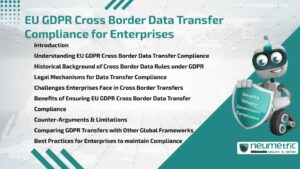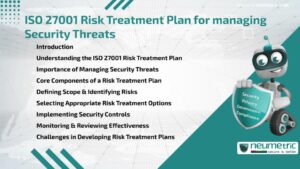Table of Contents
ToggleIntroduction
The ISO 27001 Risk treatment plan is a critical element of an organisation’s Information Security Management System [ISMS]. It outlines how identified Risks are addressed to ensure compliance with ISO 27001 Certification requirements & to protect Critical Assets. By systematically managing Security Threats, enterprises can reduce Vulnerabilities, maintain Data Security & meet Business Objectives & Customer Expectations. This article explains the components, challenges & Best Practices for implementing an effective Risk Treatment Plan.
Understanding the ISO 27001 Risk Treatment Plan
An ISO 27001 Risk treatment plan details the actions an organisation will take to mitigate, transfer, accept or avoid Risks identified during a Risk Assessment. It ensures that decisions on handling Security Threats are documented, reviewed & aligned with Regulatory Standards.
Importance of Managing Security Threats
Without a structured Risk Treatment Plan, organisations leave themselves open to Cybersecurity Threats, Regulatory non-compliance & potential Financial losses. An ISO 27001 Risk treatment plan strengthens trust with Clients & Partners & demonstrates a proactive approach to managing Security Threats.
Core Components of a Risk Treatment Plan
Key components of an ISO 27001 Risk treatment plan include:
- Identified Risks & their Likelihood & Impact
- Chosen treatment option (avoid, transfer, mitigate or accept)
- Selected Security Controls
- Responsibilities & ownership
- Timelines for implementation
- Methods for monitoring effectiveness
Defining Scope & Identifying Risks
The process begins by Defining Scope-what Systems & Data are included-and identifying Assets, Risks & Vulnerabilities. Organisations then evaluate the Likelihood & Impact of Threats, ensuring that critical issues receive priority.
Selecting Appropriate Risk Treatment Options
Each identified Risk must be addressed through one of four approaches:
- Avoidance: eliminating activities that introduce Risk
- Mitigation: implementing Security Controls to reduce Risk
- Transfer: outsourcing or insuring against Risk
- Acceptance: tolerating Risk when impact is minimal
Implementing Security Controls
Controls such as Access Controls, Encryption, Security Monitoring & Incident Response Plans are applied based on treatment decisions. These measures align with ISO 27001 Certification requirements & improve overall Security Posture.
Monitoring & Reviewing Effectiveness
Continuous Monitoring & Improvement ensures that Security Controls remain effective. Organisations should review treatment plans during Management Review Meetings & update them as Threats evolve.
Challenges in Developing Risk Treatment Plans
Common challenges include:
- Accurately assessing Likelihood & Impact of Risks
- Resource Constraints for smaller enterprises
- Balancing security investment with Business Objectives
Addressing these challenges requires expertise, planning & commitment to Continuous Improvement.
Takeaways
- The ISO 27001 Risk treatment plan is central to addressing Security Threats
- It defines Risk options: avoid, mitigate, transfer or accept
- Implementation of Security Controls strengthens Data Security
- Ongoing monitoring ensures continuous effectiveness
- Proper planning builds compliance & Customer Trust
FAQ
What is an ISO 27001 Risk treatment plan?
It is a documented plan describing how identified Risks will be managed under ISO 27001 requirements.
Why is an ISO 27001 Risk treatment plan important?
It ensures Security Threats are addressed systematically, reducing Vulnerabilities & ensuring compliance.
What options exist in an ISO 27001 Risk treatment plan?
Options include avoiding, mitigating, transferring or accepting Risks.
Who is responsible for the ISO 27001 Risk treatment plan?
Responsibilities are usually assigned to Information Security Officers or designated Risk owners.
How often should an ISO 27001 Risk treatment plan be reviewed?
It should be reviewed regularly, often annually & during Management Review Meetings.
What challenges exist in implementing an ISO 27001 Risk treatment plan?
Challenges include limited resources, complex Risk analysis & evolving Cybersecurity Threats.
How does an ISO 27001 Risk treatment plan support compliance?
It aligns security practices with ISO 27001 Certification requirements, ensuring documented & effective treatment of Risks.
Need help for Security, Privacy, Governance & VAPT?
Neumetric provides organisations the necessary help to achieve their Cybersecurity, Compliance, Governance, Privacy, Certifications & Pentesting needs.
Organisations & Businesses, specifically those which provide SaaS & AI Solutions in the Fintech, BFSI & other regulated sectors, usually need a Cybersecurity Partner for meeting & maintaining the ongoing Security & Privacy needs & requirements of their Enterprise Clients & Privacy conscious Customers.
SOC 2, ISO 27001, ISO 42001, NIST, HIPAA, HECVAT, EU GDPR are some of the Frameworks that are served by Fusion – a SaaS, multimodular, multitenant, centralised, automated, Cybersecurity & Compliance Management system.
Neumetric also provides Expert Services for technical security which covers VAPT for Web Applications, APIs, iOS & Android Mobile Apps, Security Testing for AWS & other Cloud Environments & Cloud Infrastructure & other similar scopes.
Reach out to us by Email or filling out the Contact Form…





